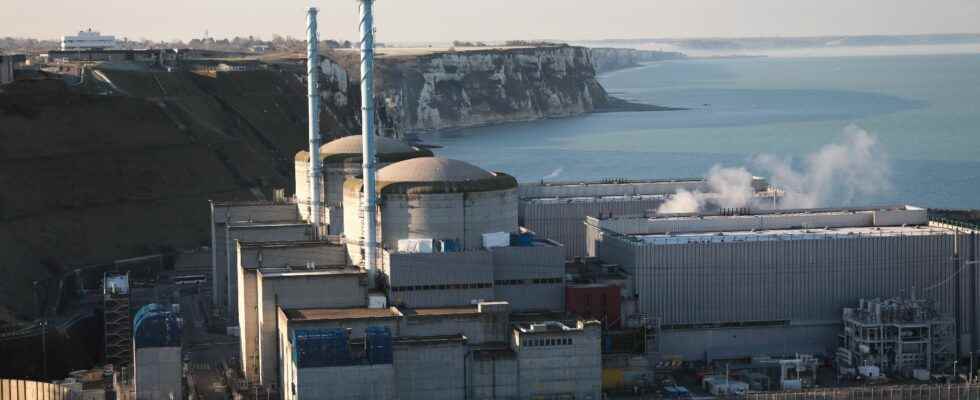This is yet another anomaly that could cost the electricity giant EDF dearly, whose fleet has already been heavily disrupted since 2021. Passed unnoticed until its media coverage on Tuesday March 7 by the site Context, an EDF note published on February 24 indicates that it has detected on the Penly 1 site, in Seine-Maritime, a “significant stress corrosion defect”, on an emergency pipe used to cool the reactor in the event of an emergency. In other words, a major crack has been detected in the piping. A visibly persistent problem in the EDF fleet, which forced the nuclear safety authority (ASN) to ask EDF to “revise its strategy” to solve these recurring problems.
What are the risks ?
On the Penly 1 site, this new defect was detected during “metallurgical expertise” on “a weld deposited in January”, according to the note published on the group’s website. It is due to what is called a “stress corrosion” mechanism, which appears under the effect of several concomitant factors including the use of a sensitive material and the presence of a favorable chemical environment.
“This event had no consequences for the personnel or the environment. However, it affects the safety function linked to the cooling of the reactor”, underlines the ASN in its information note. And for good reason, the crack detected is located on an emergency circuit of reactor number 1 of the Penly site, and more precisely “within the radioactive zone, in the reactor building”, specified the operator on the website of the power plant.
This crack, which is near a weld, “extends over 155 mm, or approximately a quarter of the circumference of the pipe, and its maximum depth is 23 mm, for a pipe thickness of 27 mm”, details the ASN. In other words, there is a risk of leakage from the piping. According to analysts, the piping could have been weakened by a repair operation aimed at “realigning” the circuits, at the very time of the construction of the reactor in the 1980s. “Because of its potential consequences and the increased probability of a rupture”, the ASN classified this safety event “at level 2 of the international scale of nuclear and radiological events”, known as the INES scale, which into account 8.
What are the consequences for electricity production?
The Penly power plant, made up of two reactors, was commissioned between 1990 and 1992. It is part of the series of the most powerful reactors available to France, known as “P’4”, with a power of 1,300 MW.
Tuesday afternoon, EDF was not able to specify whether this defect is likely to prolong the shutdown of the Penly 1 reactor, or to cause the early shutdown of other reactors for control. The impact on electricity production is therefore not specified at this stage.
However, the phenomenon had already been detected previously by the operator. The first cracks resulting from stress corrosion were thus discovered for the first time in Civaux, in Vienne, in the fall of 2021. Since then, EDF’s nuclear fleet (comprising a total of 56 reactors) has indeed suffered an unprecedented industrial crisis. This problem had forced EDF to stop many reactors for large-scale control and repair operations, contributing to the colossal losses of 17.9 billion euros recorded by the electrician last year.
Why did the ASN order EDF to “revise its strategy”?
As soon as it became aware of the incident, the Nuclear Safety Authority (ASN) asked EDF on Tuesday to “revise its strategy” on the treatment of stress corrosion in some of its reactors. If EDF has for the time being refused to comment, this problem is not new in its fleet of reactors, hence the request supported by the nuclear policeman. A year and a half ago, the electricity giant had already detected a generic problem of microcracks, a problem common to several reactors.
The reactor in question at Penly has also been shut down for nearly a year, as part of the vast “corrosion under stress” control program set up by EDF. But so far, the phenomenon observed by EDF has only revealed microcracks. “What is new is the depth of the crack, i.e. 85% of the thickness of the pipe, and the explanatory factor linked to this notion of double repair during a circuit realignment operation”, indicates to the Agence France Presse Yves Marignac, energy expert and member of the ASN’s permanent groups of experts. For the expert, “the fact that larger cracks are possible raises the question of keeping the 6 reactors of the same type P’4 in operation”, pending their preventive repair scheduled for 2023. Of the 16 reactors, the most recent and identified as the most sensitive, 10 reactors still need to be inspected and repaired in 2023: 6 must be repaired automatically, without going through the inspection phase and 4 will continue the work started in 2022, EDF indicated to the AFP.
